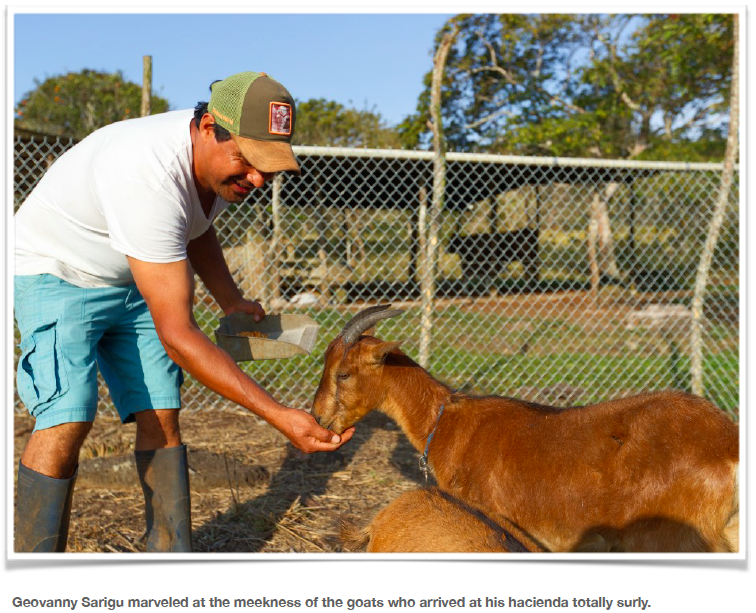By: Fernando Sanchez
“These goats are not going to leave this plot of land” , states Geovanny Sarigu, rancher and manager of Hacienda Tranquila on San Cristobal, Galapagos. Geovanny’s words echo the stories of the local fisherman who traditionally hunt the goats in the National Park. “There are countless herds of goats dying at this moment in the national park’s land due to the drought we are going through”. The goats have come from hell to stay in goat heaven. On the farm they are fed guava, oranges, corn and more importantly, they’re fed with love. Every day Geovany and his family take tender care of these animals, hoping in the future they can make an industry out of goat milk and cheese.

As a consequence of Covid 19, the tourist dependent economy in the Galapagos has been hit very hard. For the first time in the history of tourism in the Galapagos there is not an entire fleet of yachts loaded with tourists cruising around the Islands. The hotels are empty and the streets are desolate in all the major towns in the archipelago. Most international news regarding the Galapagos is about the endangered endemic species of flora and fauna, but this time the problems are with a very well known species ” the homo sapiens”. There are many families completely dependent on tourism who are without any income since last February. Tourism will take a long time to recover, and in the meantime many people are hungry and feeling desperate. In recent months, hundreds of people have been protesting in the streets, trying to get the government’s attention, and looking for solutions to the economic crisis, but problems aren’t going to vanish that easily. Many people are trying to find opportunities to expand new options for industry in the Galapagos.
“A group of farmers who are committed to a new industry”
Groups like the Association of Goat Farmers from San Cristobal Island are aiming to find opportunities in this difficult environment. The goats that are still found on a couple of the Galapagos Islands were introduced over two centuries ago. It seems like they’ve been trapped in an evolutionary bubble, their genetic pool has not had any alteration due to their long geographic isolation, without human interference. Over time, they’ve adapted to the harsh conditions in the Galapagos Islands, surviving by walking on jagged lava fields and sometimes drinking out of brackish water puddles. There is no doubt that these goats are having a hard time living in a place where they don’t belong.

Oranges abound in San Cristobal and are one of the goat’s favorite meals
The goats were very successful in colonizing the Galapagos, because they are a fast-breeding animal with an appetite for most kinds of plants. Actually, within a few years after their introduction, the population was so large that scientists account that they once outnumbered the emblematic Galapagos giant tortoise by 20 to 1.

The Galapagos National Park Service, with the support of several NGO’s, have invested several million dollars in trying to completely eradicate all the wild goats on all the Islands of the Galapagos. It has been achieved almost completely in all the islands, and it was much needed as the goats were competing for food with endemic species, such as the giant tortoise and the land iguana and destroying their habitat. The farmers who support this new goat industry say that there are many benefits in this new alternative. Comparing the chemical composition of goat milk to regular cow milk, it is lower in sugars and fat, but richer in minerals. The milk derivatives, such as cheese, are found to be quite valuable in other countries, so they could potentially become a valuable export for the Galapagos, benefiting the economy of many families in the near future.

Another important piece of this puzzle is that aside extracting resources from the sea, the fishermen are given an alternative source of income. They are normally paid by farmers to go into national park’s land to hunt and capture the goats. By doing that, they are removing them from where they are regarded as an invasive pest, to a farm, where the goats are fenced in and managed technically, kind of like a goat rehab. If they are there provided with nutritious food, shelter and love, there is no reason for them to have to return to their previously difficult environment on the national park land. Therefore from the economic crisis a mutual benefit has arisen between the local community and the conservation of the Galapagos.